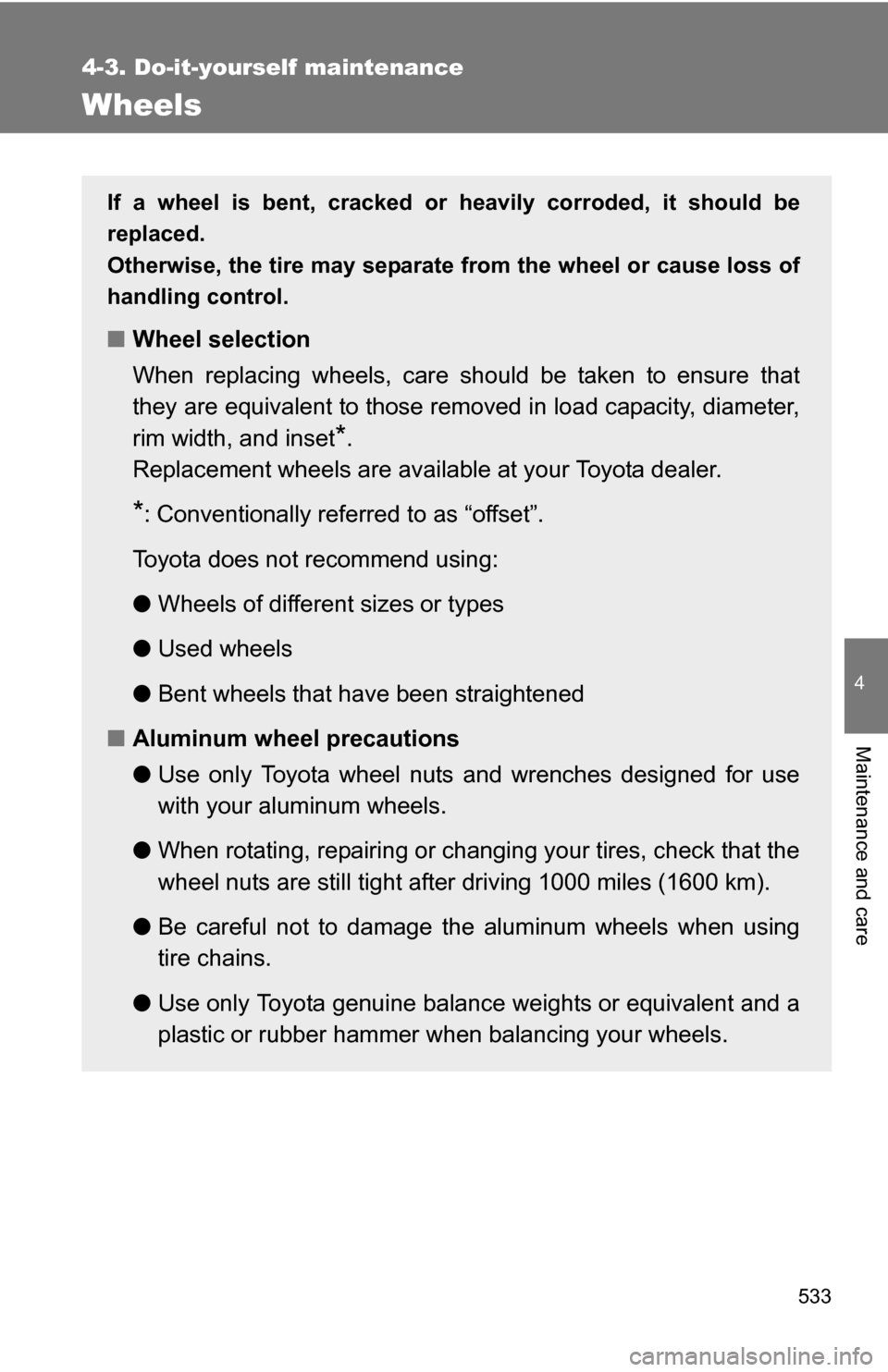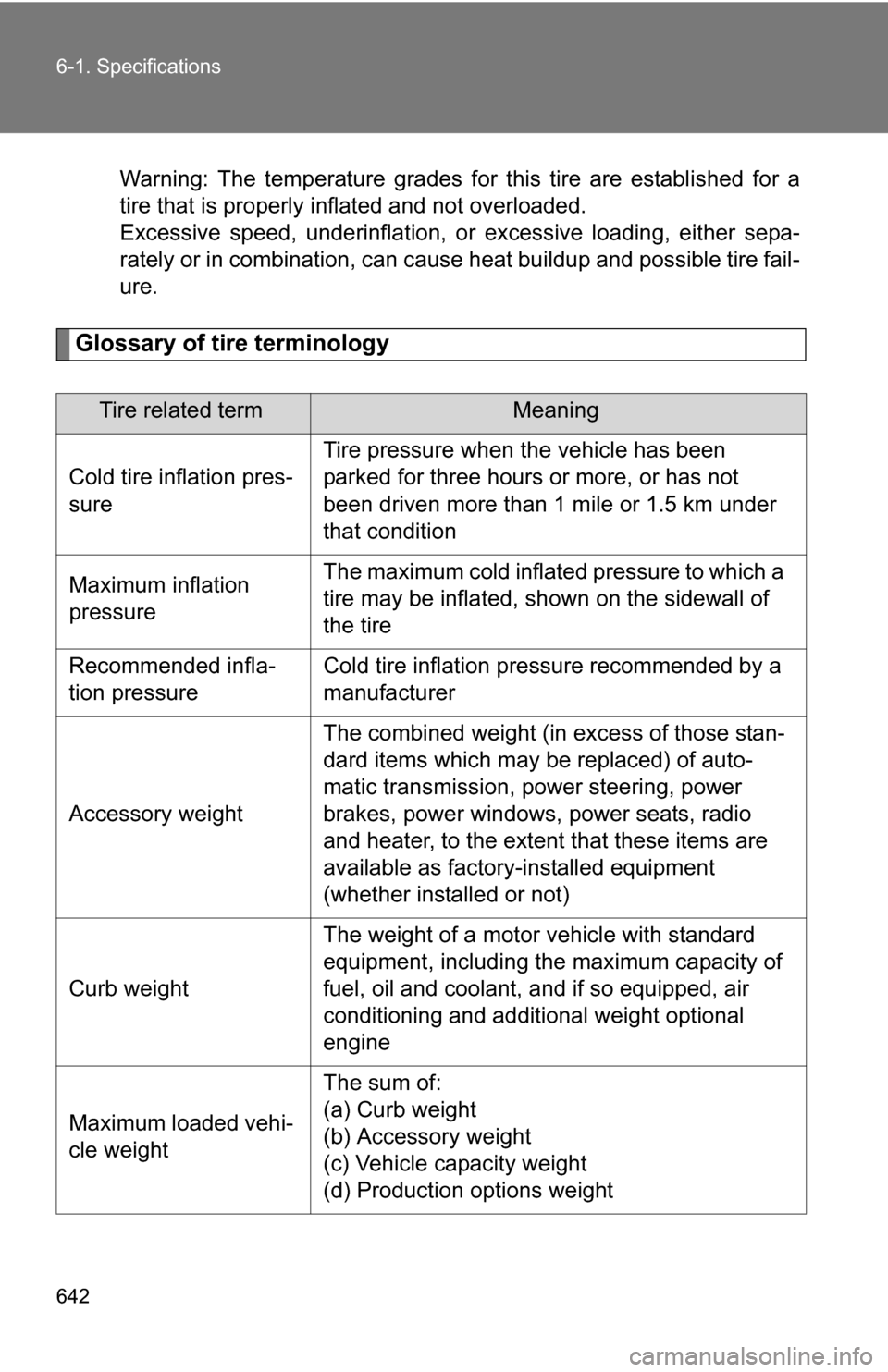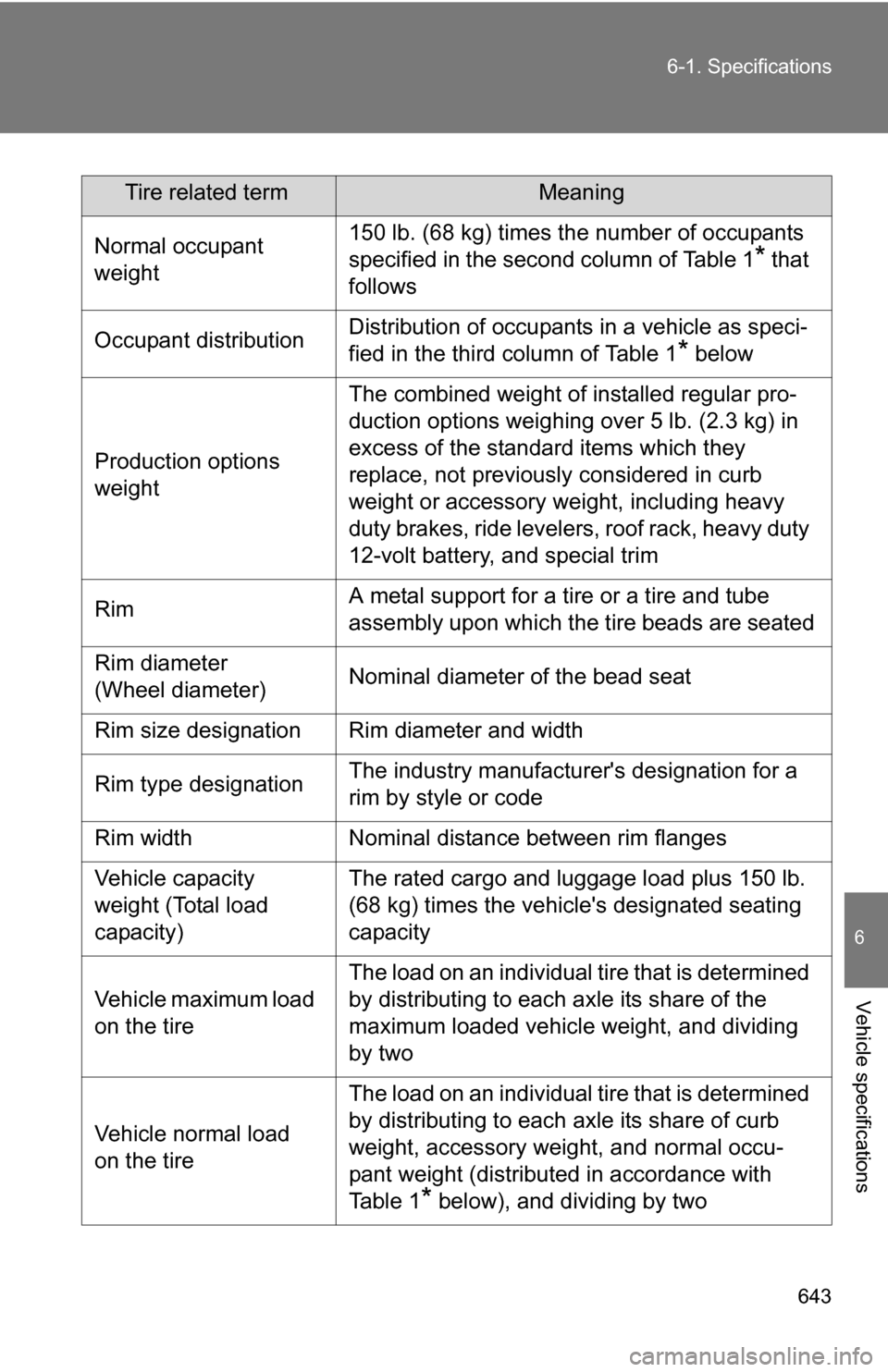2013 TOYOTA HIGHLANDER load capacity
[x] Cancel search: load capacityPage 526 of 684

526 4-3. Do-it-yourself maintenance
■Tire types
1 Summer tiresSummer tires are high-speed performance tires best suited to highway
driving under dry conditions. Sinc e summer tires do not have the same
traction performance as snow tire s, summer tires are inadequate for
driving on snow-covered or icy roads. For driving on snow-covered
roads or icy roads, the use of snow tires is recommended. When
installing snow tires, be sure to replace all four tires.
2 All season tires All season tires are designed to provide better traction in snow and to
be adequate for driving in most winter conditions, as well as for use
year round. All season tires, however, do not have adequate traction
performance compared with snow tires in heavy or loose snow. Also,
all season tires fall short in acceleration and handling performance
compared with summer tires in highway driving.
3Snow tires For driving on snow-covered roads or icy roads, we recommend using
snow tires. If you need snow tires, select tires of the same size, con-
struction and load capacity as the or iginally installed tires. Since your
vehicle has radial tires as original equipment, make sure your snow
tires also have radial construction. Do not install studded tires without
first checking local regulations for possible restriction. Snow tires
should be installed on all wheels. ( P. 248)
■Initializing the tire pr essure warning system
Initialize the tire pressure warning sy stem with the tire inflation pressure
adjusted to the specified level.
■If you push the tire pressure warning reset switch accidentally
If initialization is performed, adjust the tire in flation pressure to the speci-
fied level and initialize the tire pressure warning system again.
Page 533 of 684

533
4-3. Do-it-yourself maintenance
4
Maintenance and care
Wheels
If a wheel is bent, cracked or heavily corroded, it should be
replaced.
Otherwise, the tire may separate from the wheel or cause loss of
handling control.
■Wheel selection
When replacing wheels, care should be taken to ensure that
they are equivalent to those removed in load capacity, diameter,
rim width, and inset
*.
Replacement wheels are available at your Toyota dealer.
*: Conventionally referred to as “offset”.
Toyota does not recommend using:
● Wheels of different sizes or types
● Used wheels
● Bent wheels that have been straightened
■ Aluminum wheel precautions
●Use only Toyota wheel nuts and wrenches designed for use
with your aluminum wheels.
● When rotating, repairing or changing your tires, check that the
wheel nuts are still tight after driving 1000 miles (1600 km).
● Be careful not to damage the aluminum wheels when using
tire chains.
● Use only Toyota genuine balance weights or equivalent and a
plastic or rubber hammer when balancing your wheels.
Page 622 of 684
![TOYOTA HIGHLANDER 2013 XU50 / 3.G Owners Manual 622 6-1. Specifications
Lubrication system (2.7 L 4-cylinder [1AR-FE] engine)
*: The engine oil capacity is a reference quantity to be used when exchanging.
Warm up and turn off the engine, wait more TOYOTA HIGHLANDER 2013 XU50 / 3.G Owners Manual 622 6-1. Specifications
Lubrication system (2.7 L 4-cylinder [1AR-FE] engine)
*: The engine oil capacity is a reference quantity to be used when exchanging.
Warm up and turn off the engine, wait more](/manual-img/14/6413/w960_6413-621.png)
622 6-1. Specifications
Lubrication system (2.7 L 4-cylinder [1AR-FE] engine)
*: The engine oil capacity is a reference quantity to be used when exchanging.
Warm up and turn off the engine, wait more than 5 minutes, and check the oil
level on the dipstick.
■Engine oil selection
“Toyota Genuine Motor Oil” is used in your Toyota vehicle. Use
Toyota approved “Toyota Genuine Motor Oil” or equivalent to satisfy
the following grade and viscosity.
Oil grade: ILSAC multigrade engine oil
Recommended viscosity: SAE 5W-20 or 0W-20
SAE 5W-20 or 0W-20 engine oil
may be used. However, SAE
0W-20 is the best choice for
good fuel economy and good
starting in cold weather.
Oil viscosity (0W-20 is explained here as an example):
• The 0W in 0W-20 indicates the characteristic of the oil which allowscold startability. Oils with a lower value before the W allow for easier
starting of the engine in cold weather.
• The 20 in 0W-20 indicates the viscosity characteristic of the oil when the oil is at high temperature. An oil with a higher viscosity (one with a
higher value) may be better suited if the vehicle is operated at high
speeds, or under extreme load conditions.
Oil capacity
(Drain and refill
reference*) Without filter
With filter 4.2 qt. (4.0 L, 3.5 Imp. qt.)
4.6 qt. (4.4 L, 3.9 Imp. qt.)
Outside temperature
Page 624 of 684
![TOYOTA HIGHLANDER 2013 XU50 / 3.G Owners Manual 624 6-1. Specifications
Lubrication system (3.5 L V6 [2GR-FE] engine)■ Engine oil selection
“Toyota Genuine Motor Oil” is used in your Toyota vehicle. Use
Toyota approved “Toyota Genuine Motor TOYOTA HIGHLANDER 2013 XU50 / 3.G Owners Manual 624 6-1. Specifications
Lubrication system (3.5 L V6 [2GR-FE] engine)■ Engine oil selection
“Toyota Genuine Motor Oil” is used in your Toyota vehicle. Use
Toyota approved “Toyota Genuine Motor](/manual-img/14/6413/w960_6413-623.png)
624 6-1. Specifications
Lubrication system (3.5 L V6 [2GR-FE] engine)■ Engine oil selection
“Toyota Genuine Motor Oil” is used in your Toyota vehicle. Use
Toyota approved “Toyota Genuine Motor Oil” or equivalent to satisfy
the following grade and viscosity.
Oil grade: ILSAC multigrade engine oil
Recommended viscosity: SAE 0W-20
SAE 0W-20 is the best choice for
good fuel economy and good
starting in cold weather.
If SAE 0W-20 is not available,
SAE 5W-20 oil may be used.
However, it must be replaced
with SAE 0W-20 at the next oil
change.
Oil viscosity (0W-20 is explained here as an example):
• The 0W in 0W-20 indicates the characteristic of the oil which allowscold startability. Oils with a lower value before the W allow for easier
starting of the engine in cold weather.
• The 20 in 0W-20 indicates the viscosity characteristic of the oil when the oil is at high temperature. An oil with a higher viscosity (one with a
higher value) may be better suited if the vehicle is operated at high
speeds, or under extreme load conditions.
Oil capacity
(Drain and refill
reference) Without filter
With filter 6.0 qt. (5.7 L, 5.0 Imp. qt.)
6.4 qt. (6.1 L, 5.4 Imp. qt.)
Outside temperature
Page 642 of 684

642 6-1. Specifications
Warning: The temperature grades for this tire are established for a
tire that is properly inflated and not overloaded.
Excessive speed, underinflation, or excessive loading, either sepa-
rately or in combination, can cause heat buildup and possible tire fail-
ure.
Glossary of tire terminology
Tire related termMeaning
Cold tire inflation pres-
sure Tire pressure when the vehicle has been
parked for three hours or more, or has not
been driven more than 1 mile or 1.5 km under
that condition
Maximum inflation
pressure The maximum cold inflated
pressure to which a
tire may be inflated, s hown on the sidewall of
the tire
Recommended infla-
tion pressure Cold tire inflation pressure recommended by a
manufacturer
Accessory weight The combined weight (in excess of those stan-
dard items which may be replaced) of auto-
matic transmission, power steering, power
brakes, power windows, power seats, radio
and heater, to the extent that these items are
available as factory-installed equipment
(whether installed or not)
Curb weight The weight of a motor vehicle with standard
equipment, including the maximum capacity of
fuel, oil and coolant, and if so equipped, air
conditioning and additional weight optional
engine
Maximum loaded vehi-
cle weight The sum of:
(a) Curb weight
(b) Accessory weight
(c) Vehicle capacity weight
(d) Production options weight
Page 643 of 684

643
6-1. Specifications
6
Vehicle specifications
Tire related termMeaning
Normal occupant
weight 150 lb. (68 kg) times the number of occupants
specified in the second column of Table 1
* that
follows
Occupant distribution Distribution of occupants in a vehicle as speci-
fied in the third column of Table 1
* below
Production options
weight The combined weight of installed regular pro-
duction options weighing over 5 lb. (2.3 kg) in
excess of the standard items which they
replace, not previously considered in curb
weight or accessory weight, including heavy
duty brakes, ride levelers, roof rack, heavy duty
12-volt battery, and special trim
Rim A metal support for a tire or a tire and tube
assembly upon which the tire beads are seated
Rim diameter
(Wheel diameter) Nominal diameter of the bead seat
Rim size designation Rim diameter and width
Rim type designation The industry manufacturer's designation for a
rim by style or code
Rim width Nominal distance between rim flanges
Vehicle capacity
weight (Total load
capacity) The rated cargo and luggage load plus 150 lb.
(68 kg) times the vehicl
e's designated seating
capacity
Vehicle maximum load
on the tire The load on an individual tire that is determined
by distributing to each axle its share of the
maximum loaded vehicle weight, and dividing
by two
Vehicle normal load
on the tire The load on an individual tire that is determined
by distributing to each axle its share of curb
weight, accessory weight, and normal occu-
pant weight (distributed in accordance with
Ta b l e 1
* below), and dividing by two
Page 647 of 684

647
6-1. Specifications
6
Vehicle specifications
*: Table 1
Occupant loading and distri bution for vehicle normal load
for various designated seating capacities
Tire related termMeaning
Tread That portion of a tire that comes into contact
with the road
Tread rib A tread section running circumferentially
around a tire
Tread separation Pulling away of the tread from the tire carcass
Treadwear indicators
(TWI) The projections within the principal grooves
designed to give a visual indication of the
degrees of wear of the tread
Wheel-holding fixture The fixture used to hold the wheel and tire
assembly securely
during testing
Designated seating
capacity, Number of occupantsVehicle normal load,
Number of occupantsOccupant distribution in a normally loaded vehi- cle
2 through 4 2 2 in front
5 through 10 3 2 in front, 1 in second
seat
11 through 15 5 2 in front, 1 in second
seat, 1 in third seat, 1
in fourth seat
16 through 20 7 2 in front, 2 in second
seat, 2 in third seat, 1
in fourth seat
Page 675 of 684

675
Alphabetical index
I/M test ...................................... 494
Identification
Engine .................................. 619
Vehicle.................................. 619
Ignition switch ................. 171, 175
Illuminated entry system ........ 436
Indicator lights ........................ 188
Initialization
Items to initialize ................... 652
Inside rear view mirror.............. 95
Instrument panel light control.................................... 187
Interior lights Interior lights ......................... 436
Switch ........................... 437, 438
Wattage ................................ 632
Jack Positioning a floor jack ......... 501
Vehicle-equipped jack .......... 586
Jack handle.............................. 586
Keyless entry ............................. 48
Keys Electronic key ......................... 32
Engine switch ............... 171, 175
If the electronic key does not operate properly ........... 604
If you lose your keys/ wireless remote control
transmitter .......................... 603
Ignition switch ............... 171, 175
Key number ............................ 32
Keyless entry .......................... 48
Keys ....................................... 32
Mechanical key....................... 32
Wireless remote control key ....................................... 48 License plate lights
Replacing light bulbs .............553
Wattage .................................632
Light bulbs Replacing ..............................553
Wattage .................................632
Lights Door courtesy lights ..............436
Emergency flasher switch .....562
Fog light switch .....................210
Hazard light switch ................562
Headlight switch ....................203
Interior light switch ........437, 438
Outer foot lights .....................436
Personal light switch .............437
Replacing light bulbs .............553
Turn signal lever....................183
Vanity lights ...........................453
Wattage .................................632
Load capacity ...........................247
Lock steering column ......173, 176
Luggage cover .........................466I
J
K
L